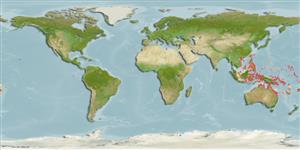>
Gobiiformes (Gobies) >
Microdesmidae (Wormfishes) > Ptereleotrinae
Etymology: Parioglossus: Greek, pareia = jaw + Greek, glossa = tongue (Ref. 45335).
Eponymy: Edward Henry Rainford (1853–1938) was an English-born Australian amateur naturalist who was viticulturist at the Queensland Agricultural Department, based at Bowen in north Queensland. He collected specimens of fauna and flora for the Australian Museum. (Ref. 128868), visit book page.
Environment: milieu / climate zone / depth range / distribution range
Ecologia
marino; salmastro associati a barriera corallina; distribuzione batimetrica 0 - 5 m (Ref. 86942). Tropical; 25°N - 28°S
Western Pacific: Philippines to Papua New Guinea, north to Yaeyama Islands, south to Queensland, Australia; including Palau and Pohnpei (Caroline Islands) in Micronesia and New Caledonia (Ref. 11889).
Size / Peso / Age
Maturity: Lm ? range ? - ? cm
Max length : 4.5 cm TL maschio/sesso non determinato; (Ref. 90102)
Short description
Chiavi di identificazione | Morfologia | Morfometria
Spine dorsali (totale) : 5 - 7; Raggi dorsali molli (totale) : 14 - 17; Spine anali: 1; Raggi anali molli: 14 - 16.
Form schools among mangroves and in coastal inlets, associate with P. formosus (Ref. 1602).
Life cycle and mating behavior
Maturità | Riproduzione | Deposizione | Uova | Fecundity | Larve
Myers, R.F., 1991. Micronesian reef fishes. Second Ed. Coral Graphics, Barrigada, Guam. 298 p. (Ref. 1602)
IUCN Red List Status (Ref. 130435: Version 2024-1)
Threat to humans
Harmless
Human uses
Strumenti
Special reports
Download XML
Fonti Internet
Estimates based on models
Preferred temperature (Ref.
123201): 25.2 - 29.3, mean 28.5 °C (based on 1481 cells).
Phylogenetic diversity index (Ref.
82804): PD
50 = 0.5000 [Uniqueness, from 0.5 = low to 2.0 = high].
Bayesian length-weight: a=0.00389 (0.00180 - 0.00842), b=3.12 (2.94 - 3.30), in cm total length, based on all LWR estimates for this body shape (Ref.
93245).
Trophic level (Ref.
69278): 3.2 ±0.4 se; based on size and trophs of closest relatives
Fishing Vulnerability (Ref.
59153): Low vulnerability (10 of 100).
